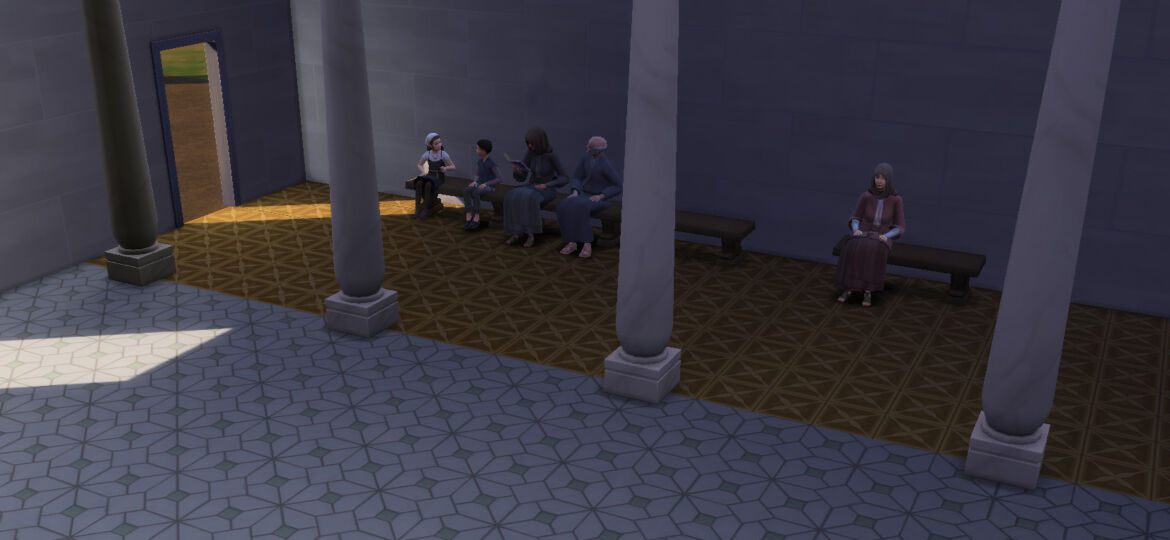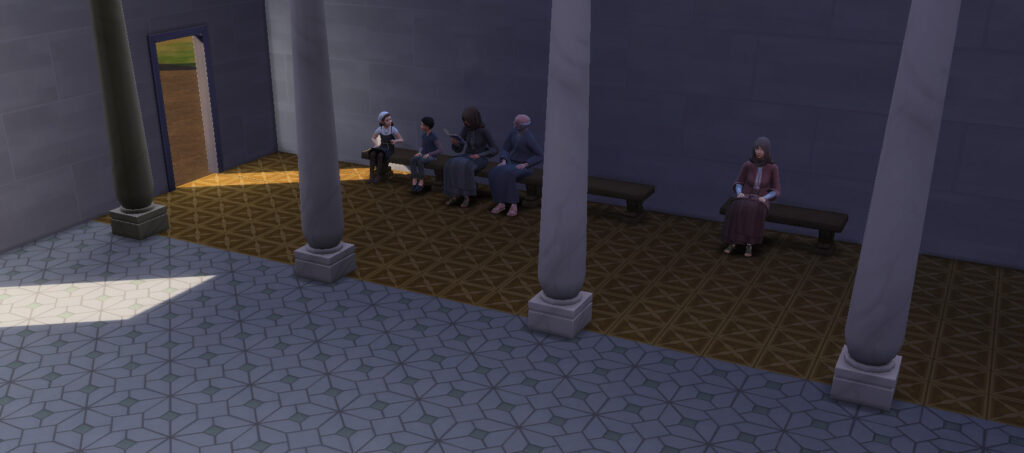
It has not been completely clarified yet where the clergy and especially the congregation stood or sat during any church service in Byzantine churches, because the contemporary sources give extremely fragmentary evidence and, depending upon different types of churches, the sitting order differed. On the other hand, as I explore below, in comparison with seats associated with the clergy, little is known about seats for the congregation. In this post, therefore, I would like to briefly speak about the seating places for ordinary people by focusing on some written and archaeological evidence.
In typical Byzantine churches, generally two types of seating places were provided. One of these was for the congregation and the other for the clergy. The best-known seating structure is the synthronon, the bench or benches reserved for the clergy. Since synthrona are located within the sacred and therefore segregated section of the church, that is, bema, these were reserved only for the clergy. The bishop, if any, sat on the episcopal chair placed in the middle, and the clergy reading the scriptures occupied the rest of the synthronon during a part of the church service. This order basically represented Christ among his disciples, according to early Christian tradition. Apart from synthrona, some early Byzantine Churches in and around Syria provided a different type of synthronon (bema), that is, a horseshoe-shaped platform in the centre of the nave, unlike those located in the apse. The synthrona of these platforms were reserved for the clergy and/or the choir and bore a similar symbolism. No doubt, apart from the two types of synthrona, some written sources also indicate that other seats were reserved inside churches for churchmen. However, these kinds of seats were never a norm or a rule and were intended mostly for the clergy, too.
As mentioned above, while seating places for the clergy in Byzantine churches are very well known, very little is known of the seats for the laypeople, that is, the Christian congregation. One of the reasons we have limited evidence is that the materials used, such as brick, wood, or even rubble stone, have not been preserved. Another, and maybe the best explanatory, reason is the reality that the bulk of the congregation gathering in the naos stood during services. Nevertheless, both archaeological evidence and written sources provide some clues as to their location, material, and form, as well as by whom these might have been used.
The practice of providing seats for the congregation is no doubt not peculiar to churches. For instance, we know that ancient synagogues also had benches, chairs, and mats, some of which were reserved for worshippers. This tradition, or, more accurately, the evidence for the indispensable need of seats for certain individuals among the worshippers, is also documented in early, “primitive” church architecture. A significant example of this early evidence for seats is the earliest identified house-church at Dura Europos in Syria from the first half of the third century CE. This Christian house-church consists of a row of rooms that encircle a courtyard. The presence of benches in the courtyard, baptistery, and the so-called assembly hall suggests that these seats must have been reserved for worshippers rather than the clergy.

From the fourth century CE onwards, Byzantine churches seem to have continued providing seats for worshippers to a certain extent. Be it in a rock-cut or a masonry church, a large number of examples have been identified across the Byzantine realm, such as Syria, Anatolia, and Greece. Here, I would like to summarize their common characteristics instead of examining each building separately. These seats are largely constructed from masonry or brick or are rock-cut, while wooden ones are also known at least from the notches in stones for wooden structures, as well as from contemporary sources. The remains of stone seats can be seen at various points of the churches, such as the aisles, naos, narthex, atrium/courtyard, and even outside the main walls. These types of seats are designed in the form of benches and are mostly positioned along the lateral walls of the naos and narthex, as well as, in a few cases, attached to the stylobate on the nave side or to the outer walls of the church.
Although the evidence is scarce, written sources enable us to interpret the possible relations between the seats and those who once used them. From as early as the third century CE onwards, the apostolic constitutions and the canons, as well as, in the ensuing centuries, the descriptions of various contemporary sources, inform us about worshippers sitting on seats in churches. The references are no doubt only local or regional and, therefore, it is difficult to generalize these to a wider region. Nevertheless, they offer several valuable clues as to their primary and indispensable functions. For instance, one of the earliest texts from the first half of the third century CE, the Didascalia apostolorum, refers to seating inside churches. It clearly recommends that a part of the congregation, such as elders, women, widows, and children, should sit. When there is not enough room, priority was given to elders. Seats of this sort might have been placed inside the Church of Tyre, dated to the early fourth century CE: speaking of the church, Eusebius mentions the benches, which were most probably reserved for lay people. The Miracles of St. Artemios, a text written in the middle of the seventh century CE, refers to the presence of stools for the congregation located in the nave of the church at Constantinople. Pratum Spirituale, which is also dated to the seventh century CE, likewise points to a man sitting in a church.
While the examples above are more likely relevant to the interior of churches, some references also indicate the presence of seats abutting the faces of the churches: in the fourth century CE, St. John Chrysostom, a native of Antioch in Syria, tells of men gathering under the porches and porticoes before going into churches. This mention reminds us of the early Byzantine churches in northern Syria with porches on the façade. Some of them were also furnished with stone seats. Needless to say, apart from the congregation, these seats had many secondary usages, as well, and several ancient writers mention such cases. For instance, St. John the Almsgiver, the Patriarch of Alexandria in the early seventh century CE, sat the whole day on a bench in front of the church every Wednesday and Friday to listen to the issues of the people.
Lastly, I would like to underline the fact that the references quoted above reveal only a small part of the whole and that they are particularly relevant to the churches such as episcopal or parish ones, at which regular service was held. Hence, we should also keep in mind that the churches with functions such as monastic, memorial, funereal, and pilgrimage might have contained a different seating order to some extent because of their different congregation, sect, or visitors.
Select Bibliography
Caseau, Béatrice. “Objects in Churches: The Testimony of Inventories.” In Objects in Context Objects in Use: Material Spatiality in Late Antiquity, edited by Luke Lavan, Ellen Swift, and Toon Putzeys, 551–80. Leiden/Boston: Brill, 2007.
Cooper, James, and Arthur John Maclean. The Testament of Our Lord. Translated into English from the Syriac with Introduction and Notes. Edinburgh: Morrison and GIBB Limited, 1902.
Doig, Allan. Liturgy and Architecture: From the Early Church to the Middle Ages. Aldershot: Ashgate Publishing, 2008.
Gibson, Margaret Dunlop. The Didascalia Apostolorum in English. Translated from the Syriac by Margaret Dunlop Gibson. London: C.J. Clay and Sons, Cambridge University Press Warehouse, 1903.
Mango, Cyril. The Art of the Byzantine Empire: 312–1453. Toronto: University of Toronto Press, 1972.
Mango, Cyril. “On the History of Templon and the Martyrion of St Artemios at Constantinople.” In Studies on Constantinople, XV, 1–13. Aldershot: Ashgate Publishing, 1997.
Maxwell, Jaclyn LaRae. Christianisation and Communication in Late Antiquity: John Chrysostom and his Congregation in Antioch. Cambridge: Cambridge University Press, 2006.
Ousterhout, Robert. Master Builders of Byzantium. Princeton, N. J.: Princeton University Press, 2008.
Pena, Igacio. The Christian Art of Byzantine Syria. London: Garnet Publishing, 1996.
Rahmani, L. Y. 1990. “Stone Synagogue Chairs: Their Identification, Use and Significance.” Israel Exploration Society 40, no. 2/3 (1990): 192–214.
Taft, Robert F. “Some Notes on the Bema in the East and West Syrian Traditions.” In Liturgy in Byzantium and Beyond, VII, 326–59. Aldershot: Variorum, 1995.
Thurston, Alban Butler et al. Butler’s Lives of the Saints Complete Edition. Westminster, M. D.: Christian Classics, Inc. Thomas More Publishing, 1990.

